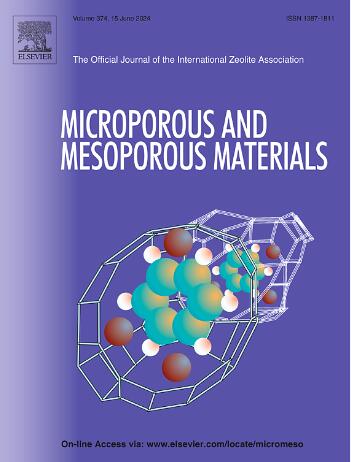Performance and mechanism of zeolite derived from coal gasification coarse slag for adsorbing Ni(II) from wastewater
IF 4.8
3区 材料科学
Q1 CHEMISTRY, APPLIED
引用次数: 0
Abstract
The heavy metal Ni2+ in water, posing a serious threat to humans and other organisms through food accumulation, can be removed using high-performance zeolites. The study successfully prepared a highly efficient Y-zeolite adsorbent from coal gasification coarse slag (CGCS) via alkali melt-seed induced hydrothermal synthesis, with an average pore diameter of 8.3 nm. The comprehensive characterization and adsorption experiments were conducted on the synthesized Y-zeolite to investigate diverse factors' influence on performance. The removal efficiency of Ni2+ reached 98.325 % within 20 min and then stabilized at 99.760 % at a dosage of 1 g L−1, pH maintained at 7.0, and an initial concentration of Ni2+ at 100 mg L−1. The adsorption process conforms to the Pseudo-second-order kinetic model and Langmuir adsorption isotherm model, with the adsorption capacity of 98.943 mg g−1 and the theoretical maximum adsorption capacity of 515.500 mg g−1. The adsorption mechanism was analyzed by SEM-EDS and FTIR, based on the ion exchange interaction between Ni2+ and T-O groups. Furthermore, DFT calculations were employed to prove the most stable site for Ni2+ adsorption on Y-zeolite. The successful adsorption of Ni2+ on suitable sites located in six-membered rings of SuCage-6mr and Cage-6mr. In conclusion, Y-zeolite showed great potential as an efficient adsorbent for Ni2+ removal, promoting the comprehensive utilization of solid waste and creating a mutually beneficial outcome.

求助全文
约1分钟内获得全文
求助全文
来源期刊

Microporous and Mesoporous Materials
化学-材料科学:综合
CiteScore
10.70
自引率
5.80%
发文量
649
审稿时长
26 days
期刊介绍:
Microporous and Mesoporous Materials covers novel and significant aspects of porous solids classified as either microporous (pore size up to 2 nm) or mesoporous (pore size 2 to 50 nm). The porosity should have a specific impact on the material properties or application. Typical examples are zeolites and zeolite-like materials, pillared materials, clathrasils and clathrates, carbon molecular sieves, ordered mesoporous materials, organic/inorganic porous hybrid materials, or porous metal oxides. Both natural and synthetic porous materials are within the scope of the journal.
Topics which are particularly of interest include:
All aspects of natural microporous and mesoporous solids
The synthesis of crystalline or amorphous porous materials
The physico-chemical characterization of microporous and mesoporous solids, especially spectroscopic and microscopic
The modification of microporous and mesoporous solids, for example by ion exchange or solid-state reactions
All topics related to diffusion of mobile species in the pores of microporous and mesoporous materials
Adsorption (and other separation techniques) using microporous or mesoporous adsorbents
Catalysis by microporous and mesoporous materials
Host/guest interactions
Theoretical chemistry and modelling of host/guest interactions
All topics related to the application of microporous and mesoporous materials in industrial catalysis, separation technology, environmental protection, electrochemistry, membranes, sensors, optical devices, etc.
 求助内容:
求助内容: 应助结果提醒方式:
应助结果提醒方式:


